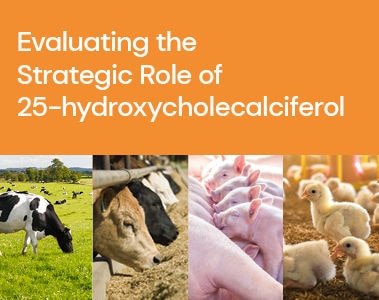Hy-D®, or dsm-firmenich’s 25-OH D3 offering, has been on the market for more than 25 years in poultry and more than 8 years in swine. Extensive research has shown that this product exerts similar vitamin D activity as cholecalciferol and therefore can either be used in combination with vitamin D3 or entirely replace this vital micronutrient in animal feeds (Soares et al., 1995). For determination of the optimum inclusion level, regulatory authorities have accepted the established conversion factor of 1 IU vitamin D3 equals 0.025 μg 25-OH-D3, which resulted in recommendations of 69 μg 25-OH-D3 / kg of feed for poultry and 50 μg 25-OH-D3 / kg of feed for swine. The safety profile of Hy-D is particularly favorable as no signs of toxicity are observed at up to a 10-fold overdose in birds and pigs (Yarger et al., 1995; Rosenberg et al, 2016).
When 25-hydroxy-cholecalciferol is used as a vitamin D3 source, the plasma concentration of 25-OH-D3 increases rapidly. It was shown that absorption of 25-OH-D3 is substantially greater than that of vitamin D in chicks (Bar et al, 1980), likely due to the fact that it occurs through passive diffusion, independent from fat uptake, rather than through an active process like the vitamin D3 absorption in the intestine. Accordingly, this compound represents an important advantage when vitamin D3 absorption is reduced due to malabsorption and other intestinal disorders (Rebel and Weber, 2009) or if the liver function is compromised. Yet, by using 25-OH-D3 the important regulation of the vitamin D3 activation is not by-passed, since the induction of the enzyme 1a-hydroxylase, which mediates the transformation of 25-OH-D3 into 1,25-(OH)2-D3 in order to adjust the Ca-P homeostasis, occurs only if plasma Ca is low.
In poultry, 25-OH-D3 is efficiently transferred to the eggs, resulting in healthier embryos that develop within stronger eggshells. This translates into improved hatchability, which in turn makes for higher survival rates among hatching chicks, and more persistent laying production cycles in breeders and laying hens. And as one day old chicks grow into chickens, they are less vulnerable to congenital and field rickets, as well as to leg disorders. Recent research indicates carcass and breast meat yield improvements at 1–2% as well as promising results in the immune response modulation.
In pigs, 25-OH-D3 from HyD has been demonstrated to improve the skeletal development of the breeding sow as well as the muscle development of the sow progeny in utero, resulting in improved growth during the growing and finishing period. This contributes to the potential for a longer productive life for sows, which means a lower sow replacement rate and a greater number of healthy piglets produced by each sow for greater lifetime performance.



